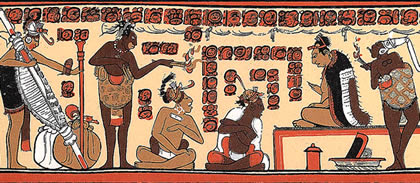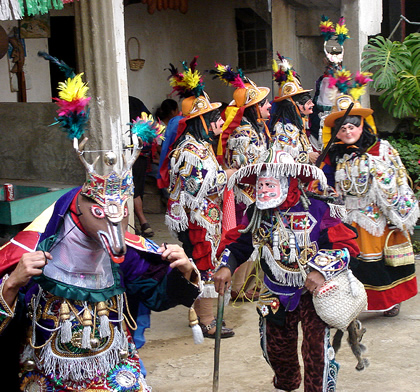World History
Today’s Quiché Maya live in Chichicastenango, Chichi for short, in the part of Quiché located in the Western Highlands of Guatemala. They survive as one of Mesoamerica’s (Middle America’s) earliest developed cultures, the Maya. According to Michael D. Coe in The Maya, the first organized agriculture in the Mayan region “was an innovation of the Preclassic period, which lasted from about 1800 b.c.e. to about 250 c.e.â€
Mayan culture would grow to encompass the Yucatán and Chiapas regions of Mexico, Guatemala, and even parts of El Salvador. The total area once occupied by the Maya was around 400,000 to 500,000 square kilometers and is referred to collectively as El Mundo Maya or in Spanish “the Maya World.â€
The Mayas, as with the later Aztecs, developed their own writing. This is in stark contrast to the earlier Olmec, from whom the Mayas may have been descended. Aside from their enigmatic monumental stone sculptures, with apparently African faces, little has been found to document the Olmec civilization. Unfortunately, as with the Aztecs, few of the Mayan written records, in books called codices, which were often made from deerskin or tree bark, survived the Spanish conquest.
Only four known Mayan codices are known to have survived the Spanish destruction, the Dresden Codex, the Madud Codex, the Paris Codex, and the Grolier Codex. More permanent records were kept in the elegant stone hieroglyphic writing, featured on almost every public building, which defied Spanish efforts to destroy it.
Today’s Quiché Maya in Guatemala occupy a land that before the Spanish conquest of the Mayas in about 1524 was the home to “by well over 25 different tribes or clans of natives who were direct descendants of the original ancient Maya. The most numerous, largest, and most influential of these tribes was the Quiché and the Cakchiquel (meaning ‘those from the red tree’).†As the Public Broadcasting System writes in Hernán Cortés Arrives in Mexico, “The first land Cortes and his crew spotted was the coast of Yucatán, at one time the central nervous system of the Mayan empire.
Although never a fully unified empire, distinct groups of Mayans occupied these areas, all sharing cultural characteristics such as a highly developed calendar, a complex writing system, and sophisticated mathematics. Even today, the Maya occupy some of these same lands and heartily preserve their significant cultures and languages. Meanwhile, General Alvarado, one of Cortés’s men who had traveled ahead, attacked a Maya temple.
Cortés reprimanded the general: it was impetuous aggression like this that could bring their expedition to a disastrous and quick end. At Punta Catoche, Cortés came across Aguilar, a man who had survived a shipwreck and spent nine years as a slave to a warlord. Cortés enlisted the man; his knowledge of Maya would be invaluable to the explorer.â€
Pedro de Alvarado destroyed the Quiché capital city of Utatlán. Indeed, Alvarado was perhaps the most homicidal of Cortés’s “great captains.†While Cortés was off in June 1520 to confront Pánï¬ lo de Narváez, who had been sent to capture Cortés, Alvarado carried out the massacre in the Aztec capital of Tenochtitlán, the site of today’s Mexico City. The massacre led to a full Aztec revolt, which almost led to the destruction of Cortés and his entire army in La Noche Triste, “The Sad Night,†of July 1, 1520.
The main source on Quiché history and culture is their book, the Popol Vuh. The author came from the Quiché Mayas, who were among those educated by the priests and friars who accompanied the Spanish. As with those who faced the Aztecs, some of them realized the value of the indigenous Middle American cultures they had encountered and dedicated their lives to preserving what had been spared in the wreckage that accompanied the conquest and its immediate aftermath.
- Southeastern Periphery Of Mesoamerica
Southeastern Periphery of Mesoamerica Southeastern Mesoamerica has been so little understood that even the two Mayan sites in the area, Copán and Quirigua, which flowered from the fifth to the ninth centuries, were thought of as the creations of itinerant...
- Quetzalcoatl
Quetzalcoatl Quetzalcoatl evokes one of the great tales of Middle American (Mesoamerican) mythology. In Nahuatl, the language of the Aztecs of Mexico, the name Quetzalcoatl can be translated as “feathered serpent.†There is in fact a quetzal...
- Pedro De Alvarado - Spanish Conquistador
Pedro de Alvarado - Spanish ConquistadorRenowned as one of the most powerful, fearless, and ruthless of all the Spanish conquistadores, Pedro de Alvarado was a key actor in the conquest of Mexico and the conquest of Central America, and a minor player...
- Popul Vuh
Popul VuhIn 1908, Lewis Spence, one of the foremost scholars of myth and religion of his day, said of the Popul Vuh, “There is no document of greater importance to the study of the pre-Columbian mythology of America than the Popol Vuh. It is the...
- Conquest Of The Yucatán
Conquest of the Yucatán The Spanish invasion and subjugation of the Maya peoples of the Yucatán Peninsula, the highlands of Chiapas, and the lowlands stretching into the Guatemalan Petén contrasted sharply with their swift defeat of the Aztec...
World History
Quiché Maya
 |
| Quiché Maya |
Today’s Quiché Maya live in Chichicastenango, Chichi for short, in the part of Quiché located in the Western Highlands of Guatemala. They survive as one of Mesoamerica’s (Middle America’s) earliest developed cultures, the Maya. According to Michael D. Coe in The Maya, the first organized agriculture in the Mayan region “was an innovation of the Preclassic period, which lasted from about 1800 b.c.e. to about 250 c.e.â€
Mayan culture would grow to encompass the Yucatán and Chiapas regions of Mexico, Guatemala, and even parts of El Salvador. The total area once occupied by the Maya was around 400,000 to 500,000 square kilometers and is referred to collectively as El Mundo Maya or in Spanish “the Maya World.â€
The Mayas, as with the later Aztecs, developed their own writing. This is in stark contrast to the earlier Olmec, from whom the Mayas may have been descended. Aside from their enigmatic monumental stone sculptures, with apparently African faces, little has been found to document the Olmec civilization. Unfortunately, as with the Aztecs, few of the Mayan written records, in books called codices, which were often made from deerskin or tree bark, survived the Spanish conquest.
  |   |
Only four known Mayan codices are known to have survived the Spanish destruction, the Dresden Codex, the Madud Codex, the Paris Codex, and the Grolier Codex. More permanent records were kept in the elegant stone hieroglyphic writing, featured on almost every public building, which defied Spanish efforts to destroy it.
Today’s Quiché Maya in Guatemala occupy a land that before the Spanish conquest of the Mayas in about 1524 was the home to “by well over 25 different tribes or clans of natives who were direct descendants of the original ancient Maya. The most numerous, largest, and most influential of these tribes was the Quiché and the Cakchiquel (meaning ‘those from the red tree’).†As the Public Broadcasting System writes in Hernán Cortés Arrives in Mexico, “The first land Cortes and his crew spotted was the coast of Yucatán, at one time the central nervous system of the Mayan empire.
Although never a fully unified empire, distinct groups of Mayans occupied these areas, all sharing cultural characteristics such as a highly developed calendar, a complex writing system, and sophisticated mathematics. Even today, the Maya occupy some of these same lands and heartily preserve their significant cultures and languages. Meanwhile, General Alvarado, one of Cortés’s men who had traveled ahead, attacked a Maya temple.
 |
| Quiché Mayan Festival |
Cortés reprimanded the general: it was impetuous aggression like this that could bring their expedition to a disastrous and quick end. At Punta Catoche, Cortés came across Aguilar, a man who had survived a shipwreck and spent nine years as a slave to a warlord. Cortés enlisted the man; his knowledge of Maya would be invaluable to the explorer.â€
Pedro de Alvarado destroyed the Quiché capital city of Utatlán. Indeed, Alvarado was perhaps the most homicidal of Cortés’s “great captains.†While Cortés was off in June 1520 to confront Pánï¬ lo de Narváez, who had been sent to capture Cortés, Alvarado carried out the massacre in the Aztec capital of Tenochtitlán, the site of today’s Mexico City. The massacre led to a full Aztec revolt, which almost led to the destruction of Cortés and his entire army in La Noche Triste, “The Sad Night,†of July 1, 1520.
The main source on Quiché history and culture is their book, the Popol Vuh. The author came from the Quiché Mayas, who were among those educated by the priests and friars who accompanied the Spanish. As with those who faced the Aztecs, some of them realized the value of the indigenous Middle American cultures they had encountered and dedicated their lives to preserving what had been spared in the wreckage that accompanied the conquest and its immediate aftermath.
- Southeastern Periphery Of Mesoamerica
Southeastern Periphery of Mesoamerica Southeastern Mesoamerica has been so little understood that even the two Mayan sites in the area, Copán and Quirigua, which flowered from the fifth to the ninth centuries, were thought of as the creations of itinerant...
- Quetzalcoatl
Quetzalcoatl Quetzalcoatl evokes one of the great tales of Middle American (Mesoamerican) mythology. In Nahuatl, the language of the Aztecs of Mexico, the name Quetzalcoatl can be translated as “feathered serpent.†There is in fact a quetzal...
- Pedro De Alvarado - Spanish Conquistador
Pedro de Alvarado - Spanish ConquistadorRenowned as one of the most powerful, fearless, and ruthless of all the Spanish conquistadores, Pedro de Alvarado was a key actor in the conquest of Mexico and the conquest of Central America, and a minor player...
- Popul Vuh
Popul VuhIn 1908, Lewis Spence, one of the foremost scholars of myth and religion of his day, said of the Popul Vuh, “There is no document of greater importance to the study of the pre-Columbian mythology of America than the Popol Vuh. It is the...
- Conquest Of The Yucatán
Conquest of the Yucatán The Spanish invasion and subjugation of the Maya peoples of the Yucatán Peninsula, the highlands of Chiapas, and the lowlands stretching into the Guatemalan Petén contrasted sharply with their swift defeat of the Aztec...
